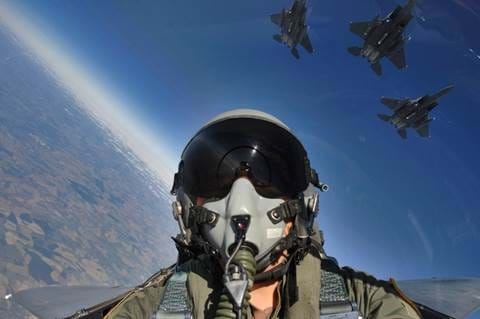Ask the Experts
Find out more about MUOS and how we are supporting this capability.

Chelton is a world leader in the design and manufacture of communications and navigation antennas. Across the battlefield and into the skies, we work with our customers to create innovative antenna systems.
We’re constantly moving with new technologies to make sure that our antennas secure mission success. With the Mobile User Objective System (MUOS) being implemented in the USA, we’ve designed an updated range of conformal antennas which have been selected to be installed on the US Air Force’s F-15 Eagle and Strike Eagle platforms.
But what is MUOS and what does the functionality enable military forces to do? We caught up with our subject matter expert Valentina Peci, Business Sales Manager and previously Product Line Manager for Antennas, to find out more about MUOS and how we are supporting this capability.

1. What are the main communication challenges faced by fighters in the battlefield?
Communication has always played an important role in the battlefield, and as technology and warfare becomes more sophisticated, it is proving to be even more critical. A war fighter in a hostile environment needs to be able to know where they are, where their comrades are and where potential threats are. To achieve this they need the right data, at the right time, to enhance their situational awareness.
Another major challenge the battlefield faces is the ability for all the different technologies used by the military to operate seamlessly. You can imagine just how high the volume of data that has to flow back and forth is, sometimes over thousands of miles – all without interruption or bottlenecks. MUOS will be able to tackle this and ensure continuity and interoperability of communications.
MUOS is the next generation narrowband tactical communications system, which will significantly improve capabilities for mobile military forces.
2. How does MUOS work?
The Mobile User Objective System (MUOS) has been developed to replace the US military’s current narrowband tactical communications system known as the Ultra High Frequency Follow-on system – UFO for short.
The MUOS space and ground segments consist of five orbiting satellites (one is a spare satellite) and four ground stations respectively. In this system, which mimics a cellular-like service, the satellites effectively act as cell towers to support communication. The user segment comprises of UHF radios, which have been upgraded to support the new MUOS Wideband Code Division Multiple Access (WCDMA) waveform. MUOS-capable radios are and will be installed on aircraft, ships, and ground platforms, and are used by dismounted soldiers to enable beyond line of sight (BLOS) communications.
3, What advantages will MUOS bring over legacy UFO SATCOM to address the existing communication challenges?
Built around the commercial 3G cellular technology, MUOS improves the performance of the network system and has a capacity 10 times greater than the legacy UFO SATCOM. It enables voice, video and data transmission over a secure, high-speed Internet Protocol (IP) based and net-centric network.
MUOS overcomes the challenges previously mentioned by Stacie, as more users will be able to access the system when they need it. The new satellite system supports stable on-the-move and point-to point (P2P) communications. In addition, MUOS integrates with the Global Information Grid (GIG) and can connect to the Defense Information System Network (DISN), the Department of Defense (DoD) network, over SATCOM.
As it continues to operate in the UHF spectrum, MUOS is less susceptible to blockages and attenuations by difficult terrain conditions, foliage and other obstructions, compared to higher frequency signals.
Furthermore, it provides almost worldwide coverage, including the Polar Regions. MUOS satellites were required to enable communications at latitudes as high as 65° North and 65° South. However, according to Lockheed Martin, one of the key subcontractor for MUOS, the constellation’s actual reach extends as far north as 89.5° latitude. This is impressive considering that the satellites are located in geosynchronous orbit*.
|
*What is a geosynchronous orbit? This is an Earth-centred orbit with an orbital period that matches the Earth’s rotation on its axis meaning the satellites stay in a fixed location to Earth. |
4. Will the move to MUOS render legacy UFO SATCOM unusable?
Whenever a new technology emerges, it’s important to be able to smoothly transition from the existing system to the new one. It can’t just be switched off and swapped out for a different system. Each MUOS satellite has been designed with two payloads; one supporting the new WCDMA waveform capabilities and the other to support the legacy UHF satellite communications system. The dual-payload design will ensure the smooth transition from legacy UFO to MUOS.
The UFO system operates in the bands 244-270 MHz for downlink and 292-318 MHz for uplink. MUOS uses slightly higher frequency bands instead. In particular, 300-320 MHz for uplink and 360-380 MHz for downlink. As a result, some of our antennas have been upgraded to meet the MUOS requirement.
Chelton provides a wide range of UHF SATCOM antennas, which are both MUOS and legacy UFO compatible and are able to handle the transmit power, supporting the capabilities provided by the existing and the new systems.
5. How will this transform global tactical communications?
From thick jungles to barren deserts to the top of the Arctic Circle, MUOS will be everywhere. It has worldwide reach to support armed forces on patrol in hostile environments by providing a smartphone-like service. This allows forces on the ground to be able to communicate with each other and their commanding team with higher levels of quality and at much greater data capacity than what is available today.
This content is accurate and true to the best of the author’s knowledge. Content is for informational or entertainment purposes only and does not substitute for personal counsel or professional advice in business, financial, legal, or technical matters.
Your quote basket is currently empty
 Please select the type of quote you require for this product:
Please select the type of quote you require for this product: